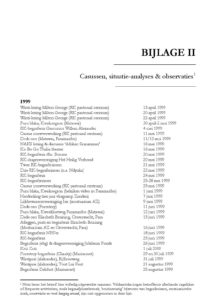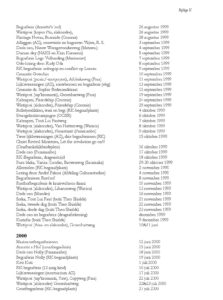Levende-Doden ~ Glossarium, Bijlagen I, II & Literatuurlijst
Glossarium – PDF
Bijlage I – Interviews – PDF
Bijlage II – Casussen, situatie-analyses & observaties[i] – PDF
i. Nota bene: het betreft hier volledig uitgewerkte casussen. Veldaantekeningen betreffende allerhande dagelijkse of frequente activiteiten, zoals begraafplaatsbezoek, ‘routinematig’ bijwonen van begrafenissen, mortuariumbezoek, rouwvisite en veel hanging around, zijn niet opgenomen in deze lijst.
Literatuur
Abbenhuis, M.F., 1966 Honderd jaar missiewerk in Suriname door de Redemptoristen, 1866-1966. Paramaribo: [s.n.].
Agerkop, T., 1982 Saramaka Music and Motion. Anales Del Caribe 2: 231-245. Read more
Joseph Semah: Breathing In Reverse
Joseph Semah, Paul Groot and Mohammed Sabet simultaneously reading Baruch de Spinoza “Tractatus theologico-politicus” in the Hebrew, Latin and Arabic languages: 23 Feb. 2008 Amsterdam (Galerie Ferdinand van Dieten – d’Eendt).
More at www.josephsemah.nl
There Is A Solution To Climate Change ~ And It Is Carbon Negative Technology
 Climate change poses the greatest threat to human civilization as we know it. Yet, governments around the world are reluctant to take drastic action to avert a climate change catastrophe even though we have the means to do so, as I will point out in the latter part of this essay.
Climate change poses the greatest threat to human civilization as we know it. Yet, governments around the world are reluctant to take drastic action to avert a climate change catastrophe even though we have the means to do so, as I will point out in the latter part of this essay.
But let’s take things from the start and look at the latest attempt of the part of the world’s governments to redress the problem of climate change, i.e., the Paris Agreement of late 2015.
In contrast to the Kyoto Protocol, whose provisions run out in 2020, the Paris deal includes no legally binding carbon dioxide emissions limits. There are no mandatory emission limits and no mandatory payments to help poor nations develop clean energy technologies, nor to mitigate the damages caused by climate change on poor nations, when the damage was historically caused by the rich nations. Mandatory emissions limits are necessary for the carbon market to operate. What is traded in the carbon market is the right to exceed one’s mandatory limits. With no mandatory limits, there can be no carbon market. The entire world is clamoring for a “price on carbon”: this is the carbon market. The six largest oil and gas companies in the world publicly support a price on carbon (Including Shell, BP, Statoil, Total and Engie). Yet the Paris Agreement undermines the very foundation for a price on carbon by requiring no mandatory emission limits.
Why did the Paris climate change negotiations move away from mandatory targets on carbon emissions and adopted instead a voluntary approach to the climate change challenge? Because a legally binding treaty that needed ratification by governments back home would have reduced substantially the chances of reaching any kind of an agreement.
This is certainly the case for one of the world’s biggest polluters, i.e., the United States. Any treaty on climate change that made its way to Capitol Hill would be shredded into pieces by the Republican-controlled Congress.
However, as time goes by, it is certain that more and more people will realize that the political compromise made in Paris over mandatory emissions comes at a great cost. Our ability to control rising temperatures caused by carbon dioxide accumulated in the air is greatly hindered since voluntary agreements guarantee failure.
But there is more. As the latest Intergovernmental Panel on Climate Change report points out, carbon emission cuts are not enough to slow down global warming. According to IPCC, we are headed with certainty towards an increase in temperatures by three degrees Celsius by 2100, although there are scientists who believe that two degrees of warming is “a recipe for disaster.” It suffices to recall the superstorm Sandy that closed down New York City for weeks, with flooded subways, leaving entire neighbourhoods without electricity, no schools, no law enforcement, and automobiles floating in the streets of this proud city. Climate change means an increase in the frequency and severity of such climate events. This means three or four Superstorm Sandies every year in New York, and the city cannot survive such climate change.
In addition to reducing drastically emissions through mandatory limits and adopting clean energy systems, it is now imperative that we utilize negative carbon technologies to remove existing carbon dioxide from the air. This was required by the IPCC, the scientific foundation of the climate negotiations, in its November 2014 5th Assessment Report. We procrastinated too much and now we have to massively reduce the CO2 that is already in the atmosphere in addition to reducing emissions. There are carbon negative technologies in Silicon Valley, like those employed by Global Thermostat, that are operating at SRI in Menlo Park California, which can offer a solution to the greatest threat facing the future of human civilization as we know it. This requires that we accept mandatory emission limits and reactivate the carbon market that is based on mandatory emissions, and was trading $175Bn/year by 2011.
The funding from the carbon market suffices to implement and scale up carbon removal around the world, as the IPCC requires, for example through carbon negative carbon plants that clean the atmosphere while they produce electricity- and do all of this in a low cost and profitable fashion. A proposal made by the author in Copenhagen COP15 was to use the Kyoto carbon market to offer finance to scale up globally such carbon negative carbon plants in poor nations, thus providing electricity that is needed by 1,3 Bn people around the world that currently have no access to electricity, all this while cleaning the planet’s atmosphere. This was called the Green Power Fund and required $200Bn/year for building carbon negative power plants; instead the Green Climate Fund was made into law, changing one word in its title and severing its connection from the source of funding, the carbon market of the Kyoto Protocol.
The reason the Climate Fund had its connection severed from its very source of funding, the carbon market of the Kyoto Protocol, was none other than the insistence of the US Congress – through its unanimously voted Byrd-Hagel Act — that there be no mandatory emissions limits.
But there is technology that can remove carbon from the atmosphere as required by IPCC. It is already operating in the Silicon Valley.
The carbon negative technologies in Silicon Valley, like those employed by Global Thermostat, which are fundamentally different from the now defunct carbon capturing and storing technologies, can offer a potential solution to the greatest threat facing the future of human civilization as we know it.
Such technologies, if employed on a global scale, can be used to clean the air from carbon dioxide, acting like trees do but much faster, as is needed now. Moreover, they are quite inexpensive and offer the potential of financial rewards, thus making them an attractive incentive to investors and enterpreneurs since, again, the logic of the global economy is not going to change overnight and we certainly cannot wait for the materialization of the “ideal society” for the planet and the future of human civilization to be saved.
At the same time, this is not to suggest that technology is magic. Technology does not exist in a vacuum nor can it be expected to be our robotic slave. We need to change today’s global financial institutions and the prevailing economic values as well. Economic values decide what is meant by economic progress. Today, economic values are based on short-sighted goals and on individualistic markets that defy logic, since they assign no value to clean air, to clean water or to biodiversity on which human survival depends. Assigning no value to the global commons–clean water, clean air, and biodiversity–leads to actions that threaten human survival. This has to change and can change. In the new Anthropocene era, humans are the most important geological force on the planet, and only with the right economic values can humankind survive.
Graciela Chichilnisky is Professor of Economics and of Statistics at Columbia University, Visiting Professor of Economics at Stanford University, Founder and CEO of Global Thermostat, and the architect of the Kyoto Protocol Carbon Market. www.chichilnisky.com
Removing CO2 From The Atmosphere
VIDEO: Removing CO2 from the atmosphere
The world cannot avoid catastrophic climate change by reducing emissions of greenhouse gases alone. Part of the solution must be removing CO2 that is already in the atmosphere, as Graciela Chichilnisky explained at the 2015 Blouin Creative Leadership Summit. She is the CEO of Global Thermostat, a firm whose revolutionary technology will be used in carbon-negative power plants that generate electricity while cleaning the atmosphere. Her equipment can convert existing fossil fuel plants, and the global carbon market’s clean development mechanism can help developing nations pay for the thousands of new clean power plants needed.
The plants will also generate revenue by using the extracted CO2 to produce carbonated beverages, fertilizers, and even synthetic gasoline. Chichilnisky envisions a future where Global Thermostat inexpensively licenses its technology to franchises all over the world, which can use crowdfunding to spread as fast as needed. She says this “is critical to resolving the climate change problem.”
Luis Triveno ~ How Latin America’s Housing Policies Are Changing The Lives Of Urban Families
In an effort to harness the benefits of urbanization and improve the living conditions of the urban poor, Latin American countries have experimented with housing subsidies. Now that the region has several decades of experience under its belt, it is time to look back and ask: Have subsidies worked? What kind of impact have they had on the lives of lower-income residents? Moving forward, how can cities pay for ongoing urban renewal?
To address those questions and share their experiences, officials in charge of designing and implementing national housing policies in eight countries (Argentina, Bolivia, Brazil, Chile, Colombia, Mexico, Paraguay, and Peru) recently met in Washington DC, along with representatives from the World Bank, Cities Alliance, the Urban Institute, and Wharton’s International Housing Finance Program.
Looking into the future, while the discussions covered a lot of ground, at least three major issues caught my attention.
1. How to align the national level policies and programs with local level decision making in urban planning and management?
Each country’s housing policy has its own unique scale, context, political circumstances and measure of progress, but a number of common challenges were clear: How to implement national housing policies when working with local governments with very diverse technical and financial capacities; and avoid and/or manage the costs of urban sprawl (both formal and informal)? The Urban Institute synthetized the US experience working with block grants channeled from Washington to local governments for community development and housing so that participants could see what best fits their realities. Although the contexts are different, all governments were interested in learning from what has worked (or has not).
Read more: http://blogs.worldbank.org/how-latin-america-s-housing-policies
Carole McGranahan & Uzma Z. Rizvi (Eds,) ~ Decolonizing Anthropology
 Just about 25 years ago Faye Harrison poignantly asked if “an authentic anthropology can emerge from the critical intellectual traditions and counter-hegemonic struggles of Third World peoples? Can a genuine study of humankind arise from dialogues, debates, and reconciliation amongst various non-Western and Western intellectuals — both those with formal credentials and those with other socially meaningful and appreciated qualifications?” (1991:1). In launching this series, we acknowledge the key role that Black anthropologists have played in thinking through how and why to decolonize anthropology, from the 1987 Association of Black Anthropologists’ roundtable at the AAAs that preceded the 1991 volume on Decolonizing Anthropology edited by Faye Harrison, to the World Anthropologies Network, to Jafari Sinclaire Allen and Ryan Cecil Jobson’s essay out this very month in Current Anthropology on“The Decolonizing Generation: (Race and) Theory in Anthropology since the Eighties.”
Just about 25 years ago Faye Harrison poignantly asked if “an authentic anthropology can emerge from the critical intellectual traditions and counter-hegemonic struggles of Third World peoples? Can a genuine study of humankind arise from dialogues, debates, and reconciliation amongst various non-Western and Western intellectuals — both those with formal credentials and those with other socially meaningful and appreciated qualifications?” (1991:1). In launching this series, we acknowledge the key role that Black anthropologists have played in thinking through how and why to decolonize anthropology, from the 1987 Association of Black Anthropologists’ roundtable at the AAAs that preceded the 1991 volume on Decolonizing Anthropology edited by Faye Harrison, to the World Anthropologies Network, to Jafari Sinclaire Allen and Ryan Cecil Jobson’s essay out this very month in Current Anthropology on“The Decolonizing Generation: (Race and) Theory in Anthropology since the Eighties.”
Read more: http://savageminds.org/series/decolonizing-anthropology/








